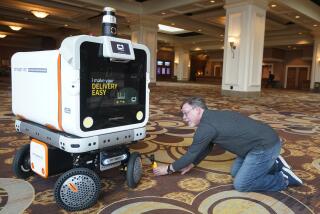Planet of the apps
- Share via
Las Vegas was the perfect setting for this year’s International Consumer Electronics Show, because the giant manufacturers that dominate the event placed a huge collective bet on 3-D. All of the best-known consumer electronics brands -- Samsung, Sony, Panasonic, LG, Toshiba and Sharp -- announced plans to sell television sets this year that are capable of displaying three-dimensional images. Sony and Panasonic also declared that they would subsidize forthcoming 3-D TV channels from ESPN and DirecTV, respectively. And a trio of Hollywood studios pledged to release 3-D Blu-ray discs of some of 2009’s theatrical 3-D hits.
The industry threw so much force behind the new feature that the shift to 3-D has an air of inevitability. Not since the launch of high-definition TV in 1998 have the major manufacturers moved with such unity, and even then there were lingering disputes over formats and displays. Still, the development feels more like something manufacturers and studios are forcing on the public, rather than a response to clamoring by consumers for a more immersive form of entertainment.
The 3-D images are certainly impressive, even delightful in some contexts. And many people with a few thousand dollars of disposable income will no doubt splurge on one of the new sets, despite the paucity of programming. (With that in mind, Toshiba and Samsung showed off sets that add a third dimension to conventional telecasts. Panasonic, by contrast, said it refused to “upconvert” 2-D images for fear of generating inferior pictures.)
But the more interesting trend on display in Las Vegas was the migration of increasingly open software platforms into more segments of the consumer electronics industry. Having transformed mobile phones, software apps are rapidly bubbling over into living rooms, kitchens and cars, making all sorts of devices more flexible, powerful and personal. That development seems much more natural and entrepreneurial than the top-down approach to 3-D.
The tone was set in Thursday morning’s keynote speech by Ford CEO Alan Mulally, who showed how the company’s new cars would integrate mobile phone apps into their stereos and dashboard display screens. And the apps phenomenon was unmistakable on the convention center floor, where devices ranging from Sony’s pint-sized Dash portable Internet viewer to Mitsubishi’s 52-inch flat-screen TVs were displaying content and services from the Web.
Despite the thunderous hype surrounding 3-D TVs, it’s safe to predict that set makers will sell far more models equipped with apps for streaming video, Internet radio, social networking and photo viewing. It’s a natural consequence of the shift manufacturers made a few years ago toward enabling their devices to connect to home networks. Outfitting TVs and Blu-ray players with Ethernet jacks cracked open a door to software developers eager to extend their reach into the living room, and the opening is getting wider by the day.

